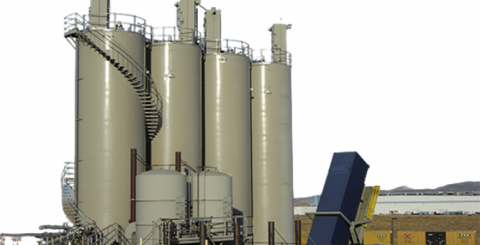The Elements of a Pneumatically Driven Conveyor System

Inside a pipe network, dry bulk materials such as grains and powders can be transported with the assistance of pneumatic conveying devices. The flow of nitrogen gas and pressure differentials are the sources of the driving power behind the exchange.
Dry commodities, such as cement, wheat, sand, plastic pellets, chemicals, minerals, and even food supplies, are examples of the kinds of things that are best transported using this method.
What Kinds of Components Can You Find in a Pneumatic Conveyor System?
The entirety of the system consists of an air mover, such as a blower, a feeder, a conveying line, a dust collector, and a vessel to collect the material when it reaches the terminal of the system.
There Are Numerous Benefits to Using a Pneumatic Conveyor System
- The Pneumatic Conveying System has the advantage of being simple to install around existing equipment and taking up minimal space on its own due to the small diameter of the pipelines used to carry goods.
- It's easier to troubleshoot and repair a system that has fewer moving parts. With this change, the system's operators and maintainers are less likely to be put in harm's way.
- Here, the substance is carried via a pipe that is hermetically sealed off from the environment. Therefore, there is less mess and spillage from the things being moved because of this strategy. Also, spills don't waste much food.
- Since air is being used to move the substance through the pipes, the procedure is quite quick.
- The hermetically sealed tube in which these procedures occur makes contamination highly unlikely.
- The flexibility of the whole system stems from the conveying system's inherent simplicity.
The Use of a Pneumatic Conveyor System for Reservations
While a Pneumatic Conveying System is a useful addition to any facility, there are a few details to consider before making the investment and they are:
- Power is required to alter air pressure to run pneumatic conveying, hence a pneumatic system requires significantly more horsepower to run than a mechanical one.
- Since the delivered material must be separated from the conveying air at the conclusion, a more robust dust-collecting system is required for pneumatic systems than for mechanical ones.
- Large-particle, high-bulk-density materials, such as pebbles and gravel, and adhesive substances, such as titanium dioxide, are not suitable for transport using pneumatic conveyors.
- Since suspended combustible bulk items pose a significant risk of ignition, this approach cannot be used to transport them.
Elements of a Pneumatically Driven Conveying System
Pneumatic conveyors use the following major parts to transport cargo:
- At first, the system relies on mechanical fans and compressors to generate the necessary air pressure and volume.
- Valves in the system prevent the compressed air from escaping and returning to the compressor.
- Computer-connected and -regulated pressure gauges and regulators for checking the PSI of the air within the compressor.
- The conveyor's load is loaded by a feeder mechanism that does not introduce any new contaminants into the transport stream.
- The pipe is the conduit through which the substance is carried.
- Pressured air is held in accumulators and buffer tanks and used to power actuators, which are often cylinders and plungers.
- A material-gas separator for collecting the dust before it's dumped into storage silos.
Materials separated from the gas are stored in silos, and lumps in the material are broken up by lump breakers to ensure the material can flow through the system without clogging or building up.
Parts and Pieces for Pneumatic Tools
The conveyor system's accessories include:
- Dump valves and terminal boxes are installed at the system's outset to complete the transfer pipe.
- Dome and switch valves allow for material to be sent to many destinations.
- Valves in tubes can reroute fluids to several different locations.
- Density stabilisers, make transportation easier by making the substance more fluid.
- Transporting this abrasive product necessitates the use of rotary vent valves.
When moving a large quantity of material, a pneumatic conveyor is an effective and economical choice. It can be useful in a spacious variety of settings, especially those involving the transportation of goods, and its use can improve productivity and accessibility.
Utilising a Vacuum to Move Substances along a Neoplastic Tube
In the industrial process, heavy objects are transferred via enormous conveyor systems. But there must be a mechanical setup that can keep moving at a consistent speed while keeping powder or granules. The vacuum conveying system uses suction to keep items in position as the belt moves.
Transferring goods to the vacuum receiver at predetermined intervals is a typical function of vacuum conveyor systems. Their mechanical and automated devices, such as extruders and conveyor belts, have significantly influenced the plastics industry.
Similar Articles
Cash flow is one of the most common challenges small businesses face, regardless of industry. Even businesses that are profitable on paper can experience financial strain when money coming in does not align with money going out.
The way of doing business in India is changing at lightning speed. Whether it is an established business owner, a startup, or a freelancer, everyone is reconsidering renting or buying physical office space.
Running a small business is a little like juggling flaming torches while riding a unicycle—on a tightrope—over a pit of alligators.
Explore how DTF printers help small businesses offer custom products with low costs, fast setup, and flexible printing for apparel, gifts, and more.
Managing finances as a small business owner can be challenging. Without a steady salary, handling income fluctuations, taxes, and expenses requires careful planning.
Do you know which is a thing that you need to consider before launching a product? A powerful first impression is what most people ignore.
Have you ever wondered how pipeline investigations are conducted, particularly in hard-to-reach areas or amidst complex landscapes? How does technology come into play in ensuring safe and efficient pipeline inspections?
Running a small business is like juggling flaming torches while riding a unicycle—you’ve got a lot going on, and one misstep can get messy fast. Nowhere is this truer than in the realm of small business accounting. Sure, numbers don’t lie, but they can be sneaky little devils if you’re not careful.
As the bare branches of winter give way to the full bloom of spring, many homeowners find themselves considering some much-needed tree maintenance. Which trees need trimming? Which ones pose a risk due to overhanging branches, or a developing lean? More crucially, how do you differentiate between the various types of tree cutting services available?









